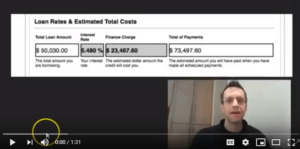By Joseph Reinke, CFA, Founder of FitBUX
One question we are often asked by FitBUX Members who use our free student loan refinance serivce is, “What is a finance charge on a loan?” This article discuss what a finance charge is, how you can reduce it, and answers a few other related questions.
Table Of Contents
- A Simple Definition
- The Finance Charge Formula
- How Can I Reduce The Finance Charge?
- How Should I View The Charge When Refinancing?
- What does “The Finance Charge Is Non-Refundable” Mean?
A Simple Definition?
A finance charge is simply the interest you would pay on the loan IF you made the required minimum, payments on the loan for the entire term of the loan. The finance charge does not take into account any prepayments you make during the time you have the loan.
For a quick video explanation of a finance charge, check out the following 90 second video:

The Finance Charge Formula
There is one easy way to calculate the finance charge:
- Take your required monthly payment and multiply it by the number of months of your loan. This is the total cost of your loan. Let’s say it’s $23,000
- Then take the amount you borrowed initially. Let’s say it is $20,000.
- The finance charge is equal to the total cost of your loan minus the amount you initially borrowed. In this example: $23,000-$20,000=$3,000.
There are other ways as well but it requires spreadsheets and/or finance calculators. Those ways are more for those in finance classes than for us in this article.
One important item to note, the finance charge formula above is for a fixed rate loan. The finance charge on a variable rate loan can’t be calculated with 100% certainty because the interest rate changes. Therefore, in your disclosure it will have a finance charge that assumes the same interest rate throughout the loan. For more on fixed vs variable rate loans, check out our guide.
How Can I Reduce The Finance Charge?
The first way to reduce the finance charge is to make prepayments, i.e. paying above and beyond what your required monthly payment is. By making prepayments on a loan you reduce how much you owe faster. This in turn reduces the interest that is charged each day. The result is a lower finance charge.
To learn more here is an article detailing the difference between a required payment and a prepayment (Coming Soon!).
The second way to reduce the finance charge is to refinance your loans. All else equal, when you refinance you reduce the interest rate on the loan. Thus, less interest is charged over time. In turn, this reduces your finance charge.
How Should I Review The Finance Charge When Refinancing?
The finance charge is the variable you need to look at to do an “apple to apple” comparison when considering student loan refinancing offers in order to make a fully informed decision.
For example, when you refinance your student loans, you may hear your FitBUX Coach say something like, “Refinancing will save you $4,000.”
What your Coach is referring to is how much you would reduce the finance charge by refinancing to a lower interest rate loan relative to your current loan situation, ALL else being equal (balance, term etc)
Contrast this with what you may see on advertising, i.e. “The average person saves $XYZ by refinancing with company blah”. In many instances, these advertisements are comparing loans with a shorter term. As we’ve explained above, if you refinance into a shorter loan, your finance charge will be lower because the loan would be shorter in the first place, regardless of the interest rate of your new loan.
Of course, there is nothing wrong with saving money by getting a lower rate AND a shorter term. You just need to keep in mind that a shorter term will mostly likely mean higher required monthly payments. This, in turn, could reduce your budget flexibility.
To learn more about this, be sure to check out our free 3 secrets of student loan refinancing webinar. You can also read our Ultimate Guide To Student Loan Refinancing.
What does “The Finance Charge Is Non-Refundable” Mean?
This confuses a lot of people when they read it on their loan documents. What it simply means is that once you make a payment you can’t get a refund of that money.
What it does NOT mean is you “absolutely” have to pay the full finance charge. Again, if you make prepayments or refinance the loan, you won’t pay the full amount of the original finance charge and this is perfectly fine, regardless of what the initial lender would like you to believe.
If you’d like to read more about money, be sure to check out FitBUX’s main blog page.


[…] A finance charge is simply the interest you would pay on the loan IF you made the required minimum, payments on the loan for the entire term of the loan. The finance charge does not take into account any prepayments you make during the time you have the loan. via […]